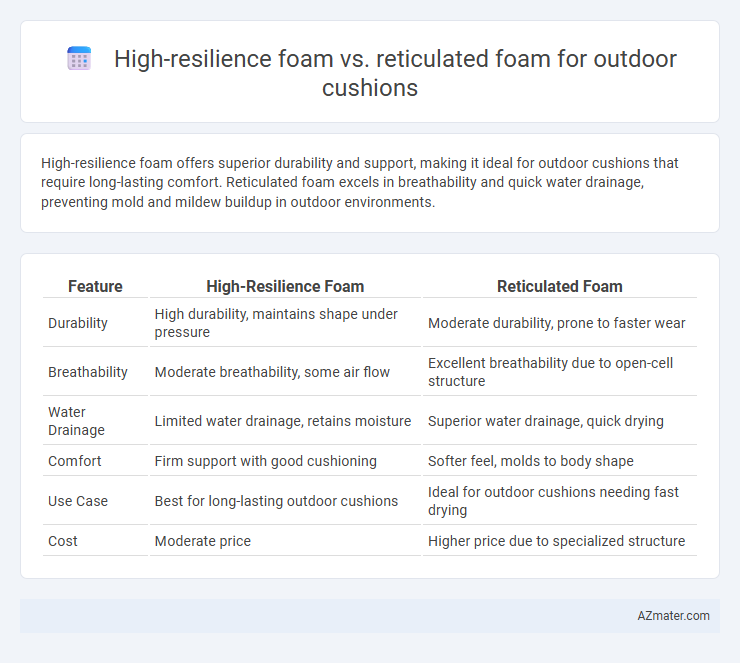High-resilience foam offers superior durability and support, making it ideal for outdoor cushions that require long-lasting comfort. Reticulated foam excels in breathability and quick water drainage, preventing mold and mildew buildup in outdoor environments.
Table of Comparison
| Feature | High-Resilience Foam | Reticulated Foam |
|---|---|---|
| Durability | High durability, maintains shape under pressure | Moderate durability, prone to faster wear |
| Breathability | Moderate breathability, some air flow | Excellent breathability due to open-cell structure |
| Water Drainage | Limited water drainage, retains moisture | Superior water drainage, quick drying |
| Comfort | Firm support with good cushioning | Softer feel, molds to body shape |
| Use Case | Best for long-lasting outdoor cushions | Ideal for outdoor cushions needing fast drying |
| Cost | Moderate price | Higher price due to specialized structure |
Introduction to Outdoor Cushion Foams
High-resilience foam offers superior durability and support for outdoor cushions, maintaining shape and comfort over extended use while resisting compression. Reticulated foam features an open-cell structure designed for quick water drainage and enhanced airflow, preventing mold and mildew buildup in outdoor environments. Selecting the right foam depends on balancing comfort, weather resistance, and longevity for optimal outdoor cushion performance.
What is High-Resilience Foam?
High-resilience foam (HR foam) is a durable, high-density polyurethane foam known for its excellent support and quick recovery after compression, making it ideal for outdoor cushions that require long-lasting comfort. It features an open-cell structure that enhances breathability and moisture resistance, helping cushions withstand varying weather conditions. HR foam's resilience prevents sagging and maintains shape over time, promoting superior comfort compared to traditional foams.
What is Reticulated Foam?
Reticulated foam is a highly porous, open-cell material designed for superior airflow and rapid water drainage, making it ideal for outdoor cushions exposed to moisture. Its structure allows quick drying and resistance to mold and mildew, unlike high-resilience foam, which offers robust support and durability but retains moisture longer. For outdoor cushions, reticulated foam enhances comfort by maintaining dryness and breathability in wet conditions.
Key Differences Between High-Resilience and Reticulated Foam
High-resilience foam offers superior durability and support with a dense, springy structure ideal for long-term outdoor cushion comfort. Reticulated foam features an open-cell design that enhances breathability and quick water drainage, making it highly resistant to mold and mildew in wet conditions. The key differences lie in high-resilience foam's emphasis on resilience and cushioning, while reticulated foam prioritizes ventilation and moisture management for outdoor use.
Durability Comparison for Outdoor Use
High-resilience foam offers exceptional durability with its strong cell structure that resists compression and maintains shape under prolonged outdoor use. Reticulated foam, characterized by its open-cell design, provides superior water drainage and breathability but tends to degrade faster due to increased exposure to moisture and UV rays. For outdoor cushions, high-resilience foam typically outperforms reticulated foam in long-term resilience, making it more suitable for environments with fluctuating weather conditions.
Water Resistance and Drainage Capabilities
High-resilience foam offers superior support and durability but tends to retain more water, making it less ideal for outdoor cushions exposed to moisture. Reticulated foam features an open-cell structure that allows excellent water drainage and quick drying, enhancing water resistance and preventing mold and mildew buildup. For outdoor cushions, reticulated foam is the optimal choice due to its enhanced drainage capabilities and resistance to water retention.
Comfort and Support Analysis
High-resilience foam offers superior support and firmness for outdoor cushions due to its dense cell structure, enhancing durability and maintaining its shape under prolonged pressure. Reticulated foam excels in comfort by providing excellent breathability and quick water drainage, preventing moisture retention and mildew growth. Combining high-resilience foam's structural support with reticulated foam's ventilation properties ensures optimal comfort and longevity for outdoor seating.
Maintenance and Cleaning Requirements
High-resilience foam resists moisture absorption, making it easier to clean with simple soap and water, and it generally dries faster, reducing mold and mildew risks. Reticulated foam's open-cell structure allows superior airflow but requires more frequent rinsing to remove dirt and debris trapped within its porous surface. Both foams benefit from protective covers to enhance durability and simplify maintenance in outdoor environments.
Cost Effectiveness and Longevity
High-resilience foam offers superior durability and maintains its shape longer, making it cost-effective for outdoor cushions by reducing replacement frequency. Reticulated foam provides excellent water drainage and quick drying, which helps prevent mold and mildew but tends to degrade faster under prolonged sun exposure, impacting longevity. Balancing initial cost with long-term performance, high-resilience foam typically delivers better overall value for outdoor cushions exposed to varied weather conditions.
Choosing the Best Foam for Your Outdoor Cushions
High-resilience foam offers excellent support and durability, ideal for outdoor cushions exposed to frequent use and weather changes, while reticulated foam features an open-cell structure that promotes superior water drainage and ventilation, preventing mold and mildew buildup. When choosing the best foam for your outdoor cushions, prioritize high-resilience foam for comfort and long-term shape retention, and select reticulated foam if moisture resistance and quick drying are essential. Combining both foams in layered cushions can maximize comfort, durability, and weather resistance for optimal outdoor performance.

Infographic: High-resilience foam vs Reticulated foam for Outdoor cushion
 azmater.com
azmater.com